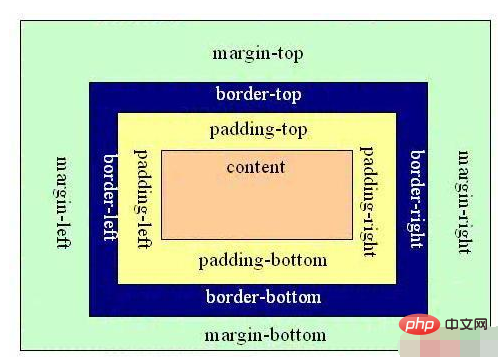Yes, float does not belong to the box attribute. Box attributes include: width, height, padding, padding-bottom, padding-left, padding-right, padding-top, margin, border, etc.

The operating environment of this tutorial: Windows 7 system, CSS3&&HTML5 version, Dell G3 computer.
The box pattern (model) is a thinking model used by CSS technology that is often used in web design. CSS assumes that all HTML document elements generate a rectangular element box that describes the space occupied by the element in the HTML document layout, which can be visualized as a box.
By defining a series of box-related attributes, the performance and layout structure of each box and even the entire HTML document can be greatly enriched and promoted.
css box mode (model), also known as box model (Box Model), is composed of several elements: element content (content), inner margin (padding), border (border), and outer margin (margin) composed (as shown in the picture below).
We can understand these attributes by transferring them to the boxes (boxes) in our daily life. The boxes we see in our daily life are also a kind of box that can hold things. They also have these attributes, so they are called It's box mode.

Box model (Flexible Box) Properties
1. Content area settings ( content):
- width: Width setting
- height: Height setting
The width and height settings can be Specific value (with unit), or it can be a percentage setting.
2. Setting of padding:
- The padding of the box is divided into four directions: top, right, bottom and left
- The setting of padding is used to control the distance between the content loaded in the box and the edge (border) of the box.
- The padding of the box occupies the space inside the box, the minimum is 0, and negative values ??are not allowed.
| Attribute | Description |
|---|---|
| padding | Use the abbreviated attribute to set in All padding properties in one declaration |
| padding-bottom | Sets the bottom padding of an element |
| padding-left | Set the left padding of the element |
| padding-right | Set the right padding of the element |
| padding -top | Set the top padding of the element |
(Learning video sharing: css video tutorial)
3. Setting of margins
- The margins of the box are divided into four directions: top, right, bottom, and left.
- The setting of margins is used Controlling the distance around the periphery of the box does not belong to the scope of the box itself
- The main purpose of the margin is to control the position of the box, so negative values ??can appear
| Attribute | Description |
|---|---|
| margin | Abbreviation attribute. Set all margin properties in one statement. |
| margin-bottom | Set the bottom margin of the element. |
| margin-left | Set the left margin of the element. |
| margin-right | Set the right margin of the element. |
| margin-top | Set the top margin of the element. |
4. Border settings
Most element objects have no borders by default
To set a border, 3 elements must be set at the same time: width, style and color.
- border composite attribute
Extended attributes of borders classified by attribute elements (border-width: border width; border-style: border style; border-color: border color )
| Attribute | Description |
|---|---|
| border | Abbreviation Attribute, used to set attributes for four sides in one statement. |
| border-style | is used to set the style of all borders of an element, or set the border style for each side individually. |
| border-width | Shorthand attribute, used to set the width of all borders of an element, or set the width of each border individually. |
| border-color | Shorthand attribute, sets the color of the visible part of all borders of the element, or sets the color for each of the 4 sides. |
| border-bottom | Abbreviation attribute, used to set all attributes of the bottom border into one statement. |
| border-bottom-color | Set the color of the bottom border of the element. |
| border-bottom-style | Set the style of the bottom border of the element. |
| border-bottom-width | Set the width of the bottom border of the element. |
| border-left | Abbreviation property, used to set all properties of the left border into one statement. |
| border-left-color | Set the color of the left border of the element. |
| border-left-style | Set the style of the left border of the element. |
| border-left-width | Set the width of the left border of the element. |
| border-right | Abbreviation property, used to set all properties of the right border into one statement. |
| border-right-color | Set the color of the right border of the element. |
| border-right-style | Set the style of the right border of the element. |
| border-right-width | Set the width of the right border of the element. |
| border-top | Abbreviation attribute, used to set all attributes of the top border into one statement. |
| border-top-color | Set the color of the top border of the element. |
| border-top-style | Set the style of the top border of the element. |
| border-top-width | Set the width of the top border of the element. |
For more programming related knowledge, please visit: Programming Video! !
The above is the detailed content of Isn't float a box attribute in html?. For more information, please follow other related articles on the PHP Chinese website!

Hot AI Tools

Undress AI Tool
Undress images for free

Undresser.AI Undress
AI-powered app for creating realistic nude photos

AI Clothes Remover
Online AI tool for removing clothes from photos.

Clothoff.io
AI clothes remover

Video Face Swap
Swap faces in any video effortlessly with our completely free AI face swap tool!

Hot Article

Hot Tools

Notepad++7.3.1
Easy-to-use and free code editor

SublimeText3 Chinese version
Chinese version, very easy to use

Zend Studio 13.0.1
Powerful PHP integrated development environment

Dreamweaver CS6
Visual web development tools

SublimeText3 Mac version
God-level code editing software (SublimeText3)

Hot Topics
 How do I minimize the size of HTML files?
Jun 24, 2025 am 12:53 AM
How do I minimize the size of HTML files?
Jun 24, 2025 am 12:53 AM
To reduce the size of HTML files, you need to clean up redundant code, compress content, and optimize structure. 1. Delete unused tags, comments and extra blanks to reduce volume; 2. Move inline CSS and JavaScript to external files and merge multiple scripts or style blocks; 3. Simplify label syntax without affecting parsing, such as omitting optional closed tags or using short attributes; 4. After cleaning, enable server-side compression technologies such as Gzip or Brotli to further reduce the transmission volume. These steps can significantly improve page loading performance without sacrificing functionality.
 How has HTML evolved over time, and what are the key milestones in its history?
Jun 24, 2025 am 12:54 AM
How has HTML evolved over time, and what are the key milestones in its history?
Jun 24, 2025 am 12:54 AM
HTMLhasevolvedsignificantlysinceitscreationtomeetthegrowingdemandsofwebdevelopersandusers.Initiallyasimplemarkuplanguageforsharingdocuments,ithasundergonemajorupdates,includingHTML2.0,whichintroducedforms;HTML3.x,whichaddedvisualenhancementsandlayout
 How do I use the element to represent the footer of a document or section?
Jun 25, 2025 am 12:57 AM
How do I use the element to represent the footer of a document or section?
Jun 25, 2025 am 12:57 AM
It is a semantic tag used in HTML5 to define the bottom of the page or content block, usually including copyright information, contact information or navigation links; it can be placed at the bottom of the page or nested in, etc. tags as the end of the block; when using it, you should pay attention to avoid repeated abuse and irrelevant content.
 How do I use the tabindex attribute to control the tab order of elements?
Jun 24, 2025 am 12:56 AM
How do I use the tabindex attribute to control the tab order of elements?
Jun 24, 2025 am 12:56 AM
ThetabindexattributecontrolshowelementsreceivefocusviatheTabkey,withthreemainvalues:tabindex="0"addsanelementtothenaturaltaborder,tabindex="-1"allowsprogrammaticfocusonly,andtabindex="n"(positivenumber)setsacustomtabbing
 What is the declaration, and what does it do?
Jun 24, 2025 am 12:57 AM
What is the declaration, and what does it do?
Jun 24, 2025 am 12:57 AM
Adeclarationisaformalstatementthatsomethingistrue,official,orrequired,usedtoclearlydefineorannounceanintent,fact,orrule.Itplaysakeyroleinprogrammingbydefiningvariablesandfunctions,inlegalcontextsbyreportingfactsunderoath,andindailylifebymakingintenti
 How do I use the and elements to provide a caption for an image?
Jun 24, 2025 am 12:45 AM
How do I use the and elements to provide a caption for an image?
Jun 24, 2025 am 12:45 AM
The standard way to add titles to images in HTML is to use and elements. 1. The basic usage is to wrap the image in the tag and add a title inside it, for example: this is the title of the image; 2. The reasons for using these two tags include clear semantics, convenient style control, and strong accessibility, which helps the browser, crawler and screen readers to understand the content structure; 3. Notes include that it can be placed up and down but needs to maintain logical order, cannot replace the alt attribute, and can contain multiple media elements to form a whole unit.
 What is the loading='lazy' one of the html attributes and how does it improve page performance?
Jul 01, 2025 am 01:33 AM
What is the loading='lazy' one of the html attributes and how does it improve page performance?
Jul 01, 2025 am 01:33 AM
loading="lazy" is an HTML attribute for and which enables the browser's native lazy loading function to improve page performance. 1. It delays loading non-first-screen resources, reduces initial loading time, saves bandwidth and server requests; 2. It is suitable for large amounts of pictures or embedded content in long pages; 3. It is not suitable for first-screen images, small icons, or lazy loading using JavaScript; 4. It is necessary to cooperate with optimization measures such as setting sizes and compressing files to avoid layout offsets and ensure compatibility. When using it, you should test the scrolling experience and weigh the user experience.
 How do I use the element to represent a section of navigation links?
Jun 24, 2025 am 12:55 AM
How do I use the element to represent a section of navigation links?
Jun 24, 2025 am 12:55 AM
The key to using elements to represent navigation link areas is semantics and clear structure, usually in conjunction with organizational links. 1. The basic structure is to put the parallel links in and wrap them inside, which is friendly to auxiliary tools and is conducive to style control and SEO; 2. Commonly used in or, for placing main navigation or footer link collections; 3. A page can contain multiple areas, such as main menu, sidebar or footer independent navigation.






